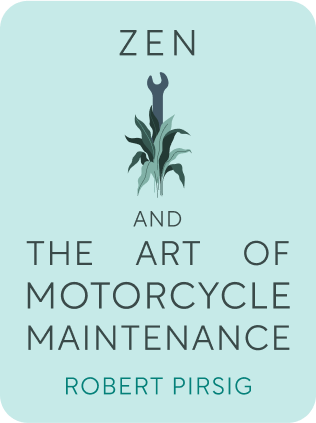

This article is an excerpt from the Shortform book guide to "Zen And The Art Of Motorcycle Maintenance" by Robert Pirsig. Shortform has the world's best summaries and analyses of books you should be reading.
Like this article? Sign up for a free trial here .
What is Zen and the Art of Motorcycle Maintenance quality about? Why is the idea of quality so important?
In Zen and the Art of Motorcycle Maintenance, quality is the idea that your life is what you make of it, and can be made better by pursuing your best self. Pirsig talks about cultivating and discovering quality.
Read more about Zen and the Art of Motorcycle Maintenance, quality, and what it means.
Quality in Zen and the Art of Motorcycle Maintenance
The hikers have stopped at a water source and are eating lunch. They’re descending the ridge along a different trail, into a different canyon. Although Chris is disappointed that they won’t be summiting the mountain, he offers to carry some of the heavy stuff Pirsig transferred to his pack.
Back on the trail, the going is relatively rough—the slope is steep, and Pirsig has to hack through the overgrown brush with his machete—but eventually the hikers make it to a road. Some fellow campers give them a ride back into Bozeman; it’s late by the time they arrive, and Pirsig decides to check them into a hotel rather than wake the DeWeeses. They’re asleep almost as soon as they lie down.
In the morning, Pirsig and Chris return to the DeWeeses’ to say their goodbyes, then they’re back on Pirsig’s cycle, heading West.
Chautauqua: Coming Down the Mountain
Pirsig wants to effect a change in emphasis, from the abstract to the practical. His final judgment is mixed on whether Phaedrus advanced human knowledge either of the Tao or Quality, but what he did achieve was an expansion of our notion of reason. Although he was a dyed-in-the-wool classical thinker, Phaedrus used the tools of rational argument to reach beyond what we typically consider rational or logical.
The first step down from Phaedrus’s abstraction to Pirsig’s practical use is to recognize that if Quality is indeed the Buddha (or the Tao)—the entity from which all other entities spring—then it unites three key areas of human experience: Art, Religion, and Science.Quality’s relation to Science is Pirsig’s primary concern, and he begins his discussion with the 19th-century French scientist and philosopher Jules Henri Poincaré—who, in his scientific researches, reached the same impasse that Phaedrus did.
Poincaré was active during a time of crisis in the physical sciences, one wrought by the appearance of the Theory of Relativity, which undermined the laws of physics as they’d been understood for years. The seeds for this crisis, as Poincaré showed in his book Foundations of Science, were actually sewn decades earlier, when mathematicians were able to propose internally consistent geometries that were incompatible both with Euclidean geometry (the standard) and each other. What this meant was that a canny mathematician could create geometries that were equally as accurate and logically sound as the one taken for granted as “true.”
The riders coast through a series of towns—Butte, Anaconda, Phillipsburg—and eventually stop at church to take a rest. Pirsig notes how lonely it is on the road without the Sutherlands. He returns to the Chautauqua to occupy his mind. In Zen and the Art of Motorcycle Maintenance, quality is next up on the list of ideas to examine.
Chautauqua: Poincaré’s Truth
Poincaré’s analysis of non-Euclidean geometries yielded this insight: that a given geometry was simply a set of conventions that was either more or less convenient for a given task; that is, no particular geometry was true but rather advantageous.
This observation led Poincaré to critique further foundational scientific concepts, space and time in particular. He found again that there is no “true” measure for space or time, only more or less useful conventions created by human beings.
The usefulness of a given convention is decided by the “facts”—observable objects and phenomena. But what Poincaré realized is that there are simply too many facts to choose from. For example, if one wants to study human life, where does one start? With the “fact” of human consciousness? The “fact” of the nervous system? The “fact” of DNA?
Poincaré sketched how a typical scientist chooses facts to concentrate on. The most important trait of a fact was its generality. If the study of a particular fact would yield knowledge of an array of related facts, then that was a better fact to explore than one that would only yield knowledge of itself.
But how can one know, before one begins experimenting, which facts are general and which are specific? Poincaré examined his own mathematical process and found that his breakthroughs came to him suddenly and inexplicably, as if out of thin air. His conclusion was that a “subliminal self” selects the proper facts based on their “beauty” and “harmony” with preexisting facts—in short, that facts are selected by an aesthetic sense rather than a strictly scientific one. This is one of the most interesting Zen and the Art of Motorcycle Maintenance quality ideas.
(Shortform note: In his exposition of Poincaré, Pirsig at times conflates two distinct senses of the word “fact.” Sometimes he uses “fact” to mean “observable phenomena”; other times, he uses it to denote a “true statement” or “rule.”)
Poincaré’s ideas, like Phaedrus’s, met with stout resistance. He, like Phaedrus, was accused of touting a radical subjectivism, a theory that turned scientific facts into “just what you like.” Poincaré didn’t refute this possibility. But what he didn’t consider was the existence of a third entity that preceded the encounter of the scientist with the fact and that drew the scientist to the fact: Quality.
When Pirsig discovered the writings of Poincaré, he became emotional, because it was clear that Phaedrus and Poincaré were struggling with the same troubling questions and coming up with similar answers. (Poincaré’s “subliminal self” corresponded with Phaedrus’s “preconscious awareness,” and the “harmony” of Poincaré’s system resembled Quality.) Phaedrus, however, went one step further than Poincaré. He proposed an all-encompassing force that organized scientists’ choices. Scientists weren’t selecting facts willy-nilly; they were being guided by a sense of Quality. In Zen and the Art of Motorcycle Maintenance, quality is transcendental and spiritual.
In Zen and the Art of Motorcycle Maintenance, quality is one of the most consistent ideas and one that fascinates the narrator.

———End of Preview———
Like what you just read? Read the rest of the world's best book summary and analysis of Robert Pirsig's "Zen And The Art Of Motorcycle Maintenance" at Shortform .
Here's what you'll find in our full Zen And The Art Of Motorcycle Maintenance summary :
- How an unnamed narrator and his son are on a cross-country motorcycle journey
- Why technology can be creative
- How to focus on what's in front of you in order to get exactly what you need






